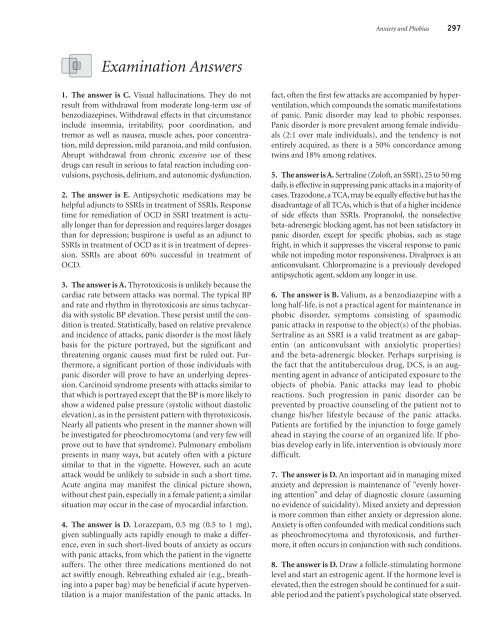NMS Q&A Family Medicine
NMS Q&A Family Medicine
NMS Q&A Family Medicine
- No tags were found...
You also want an ePaper? Increase the reach of your titles
YUMPU automatically turns print PDFs into web optimized ePapers that Google loves.
Anxiety and Phobias 297Examination Answers1. The answer is C. Visual hallucinations. They do notresult from withdrawal from moderate long-term use ofbenzodiazepines. Withdrawal effects in that circumstanceinclude insomnia, irritability, poor coordination, andtremor as well as nausea, muscle aches, poor concentration,mild depression, mild paranoia, and mild confusion.Abrupt withdrawal from chronic excessive use of thesedrugs can result in serious to fatal reaction including convulsions,psychosis, delirium, and autonomic dysfunction.2. The answer is E. Antipsychotic medications may behelpful adjuncts to SSRIs in treatment of SSRIs. Responsetime for remediation of OCD in SSRI treatment is actuallylonger than for depression and requires larger dosagesthan for depression; buspirone is useful as an adjunct toSSRIs in treatment of OCD as it is in treatment of depression.SSRIs are about 60% successful in treatment ofOCD.3. The answer is A. Thyrotoxicosis is unlikely because thecardiac rate between attacks was normal. The typical BPand rate and rhythm in thyrotoxicosis are sinus tachycardiawith systolic BP elevation. These persist until the conditionis treated. Statistically, based on relative prevalenceand incidence of attacks, panic disorder is the most likelybasis for the picture portrayed, but the significant andthreatening organic causes must first be ruled out. Furthermore,a significant portion of those individuals withpanic disorder will prove to have an underlying depression.Carcinoid syndrome presents with attacks similar tothat which is portrayed except that the BP is more likely toshow a widened pulse pressure (systolic without diastolicelevation), as in the persistent pattern with thyrotoxicosis.Nearly all patients who present in the manner shown willbe investigated for pheochromocytoma (and very few willprove out to have that syndrome). Pulmonary embolismpresents in many ways, but acutely often with a picturesimilar to that in the vignette. However, such an acuteattack would be unlikely to subside in such a short time.Acute angina may manifest the clinical picture shown,without chest pain, especially in a female patient; a similarsituation may occur in the case of myocardial infarction.4. The answer is D. Lorazepam, 0.5 mg (0.5 to 1 mg),given sublingually acts rapidly enough to make a difference,even in such short-lived bouts of anxiety as occurswith panic attacks, from which the patient in the vignettesuffers. The other three medications mentioned do notact swiftly enough. Rebreathing exhaled air (e.g., breathinginto a paper bag) may be beneficial if acute hyperventilationis a major manifestation of the panic attacks. Infact, often the first few attacks are accompanied by hyperventilation,which compounds the somatic manifestationsof panic. Panic disorder may lead to phobic responses.Panic disorder is more prevalent among female individuals(2:1 over male individuals), and the tendency is notentirely acquired, as there is a 50% concordance amongtwins and 18% among relatives.5. The answer is A. Sertraline (Zoloft, an SSRI), 25 to 50 mgdaily, is effective in suppressing panic attacks in a majority ofcases. Trazodone, a TCA, may be equally effective but has thedisadvantage of all TCAs, which is that of a higher incidenceof side effects than SSRIs. Propranolol, the nonselectivebeta-adrenergic blocking agent, has not been satisfactory inpanic disorder, except for specific phobias, such as stagefright, in which it suppresses the visceral response to panicwhile not impeding motor responsiveness. Divalproex is ananticonvulsant. Chlorpromazine is a previously developedantipsychotic agent, seldom any longer in use.6. The answer is B. Valium, as a benzodiazepine with along half-life, is not a practical agent for maintenance inphobic disorder, symptoms consisting of spasmodicpanic attacks in response to the object(s) of the phobias.Sertraline as an SSRI is a valid treatment as are gabapentin(an anticonvulsant with anxiolytic properties)and the beta-adrenergic blocker. Perhaps surprising isthe fact that the antituberculous drug, DCS, is an augmentingagent in advance of anticipated exposure to theobjects of phobia. Panic attacks may lead to phobicreactions. Such progression in panic disorder can beprevented by proactive counseling of the patient not tochange his/her lifestyle because of the panic attacks.Patients are fortified by the injunction to forge gamelyahead in staying the course of an organized life. If phobiasdevelop early in life, intervention is obviously moredifficult.7. The answer is D. An important aid in managing mixedanxiety and depression is maintenance of “evenly hoveringattention” and delay of diagnostic closure (assumingno evidence of suicidality). Mixed anxiety and depressionis more common than either anxiety or depression alone.Anxiety is often confounded with medical conditions suchas pheochromocytoma and thyrotoxicosis, and furthermore,it often occurs in conjunction with such conditions.8. The answer is D. Draw a follicle-stimulating hormonelevel and start an estrogenic agent. If the hormone level iselevated, then the estrogen should be continued for a suitableperiod and the patient’s psychological state observed.
















